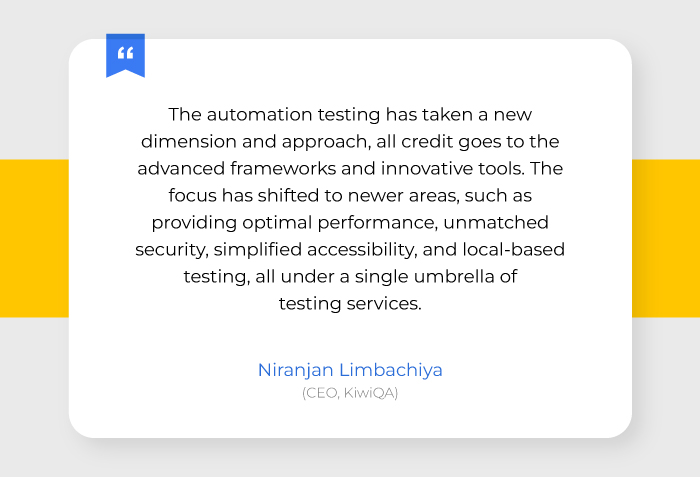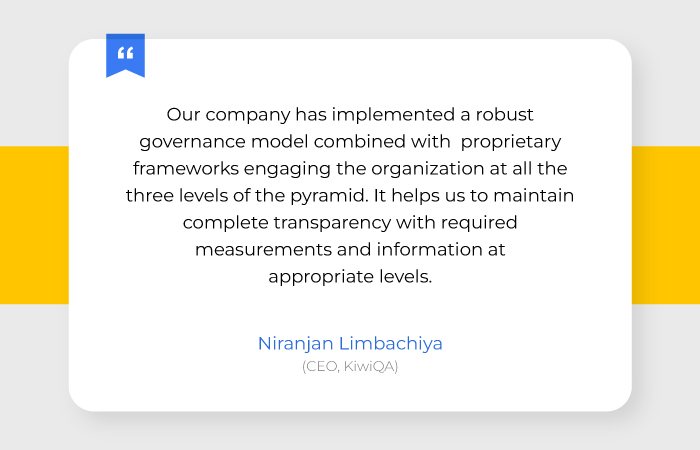Software testing is integral to software development, allowing testers and quality assurance specialists to examine the product's performance against the set criteria critically. A rigorous software testing enables developers and businesses to acutely analyze and understand the risks and perils of implementing the tool, its feasibility, and viability, in addition to its security and compliance. From A/B testing to QA testing, software testing services are available today to evaluate the product's performance.
With more businesses moving digital, there is a huge demand for high-performing, functional software. In essence, software testing is an indispensable and primary determinant of a product’s success or failure after its launch in the market. Undoubtedly, software testing has undergone a sea change in this era of digitization and technological enhancements. The introduction of new and innovative testing approaches has equipped testers with next-generation tools, accelerating, streamlining, and simplifying the process.
In the following podcast discussion, we will interact with Niranjan Limbachiya, the Chief Executive Officer of KiwiQA Services.
KiwiQA is a leading independent software testing services company that offers a wide range of testing services, such as automation testing, compatibility testing, code verification, mobile app testing, game application testing, manual testing, etc. Apart from these, the company also provides AI testing, e-commerce testing, accessibility testing, CRM testing, SEO testing, and much more.
Podcast Highlights:
- Evolution and enhancement of software testing
- Critical approaches to software testing
- Key differences between manual and automated software testing
- How different is software testing for the metaverse?
Critical Questions Answered Through this Podcast:
- How software testing and development have become inseparable?
- The role and importance of the manual testing process
- How to overcome the challenge of delivering ‘Quality at Speed’?
- The core differences between game application testing and software testing
- Role of GoodFirms in increasing the company’s customer base
The term testing has been around since 1950 but has undergone many changes per evolution. How has testing changed as per technological advancements?
Yes, it is true. The term testing that emerged during the 1950s has undone a massive transformation, all thanks to the latest technological advancements. Back then, software testing was merely limited to a handful of services, such as rectifying compilation errors and debugging a program. However, with the passage of time, new programming languages and concepts were introduced, which changed the development approaches and workflows. The enhancement in the identification of workflows based on the usage brought a paradigm shift in the perspective of testing in the mid-’90s. This brought a sea change in viewing and understanding the users' cases, main and sub-flows, alternative paths, etc., for testing the software in alignment with the data.

Let’s see how digital and next-generation technologies benefit software testing services.
- Technologies, such as artificial intelligence, machine learning, and metaverse, have modernized and automated software testing.
- It has accelerated the process, providing more accurate results for bug fixes and other issues.
- It has also helped to plan multiple cycles of testing efficiently.
In the past, development and testing were treated as mutually independent activities. They had limited interactions and weren’t actively involved during the requirement phase. However, this has changed. What has changed in making software testing an important part of the development procedure?
I agree with what you said. Software development and software testing were two different and separate entities in the past, mutually independent from each other. Hence, testing was only carried out once the development was over. This approach is known as Classic Waterfall Development. Traditionally, one can view this as Quality Control.
However, the introduction of ‘V-Model’ has transformed software testing by replacing Quality Assurance in place of Quality Control. It also leads to improving the quality of software. One of the significant aspects of Quality Assurance is that it allows software developers and testers to work in tandem with one another, where testers start working in the early stages of the software development lifecycle along with the development team. Their first-hand task is creating user scenarios, typically test scenarios.
Another crucial change is the launch of the shift-left approach. It categorized test design and test execution as two critical activities. Testers or quality assurance specialists also need to focus on three essential testing types, such as
- System Testing
- Integration Testing
- Unit Testing

Technology is changing at an exponential and unprecedented rate, and so are the ways in which organizations develop, validate, deliver, and use software. What testing approach does KiwiQA use?
We at KiwiQA emphasize implementing innovative technologies, whether we are adopting manual software testing or automated software testing.
In the case of manual testing, we have focused on using conceptual frameworks like K-RAISINS for optimal test design, with stress on coverage. On the contrary, K-E-2-E has enabled us to stitch an end-to-end testing framework.
While carrying out automated testing, we have developed a proprietary integrated framework called, K-FAST. It seamlessly incorporates CI/CD tools and simplifies and accelerates automation development.
When it comes to non-functional testing, we ensure that performance testing implements K-SPARC, L10N I18N, and G10N palletizing software and works through K-LOK and security testing. Apart from these, we have also considered a robust executional framework that allows us to perform a thorough Security check of the Application under Test (AUT).

What is the difference between automated and manual testing, and which is best for startups?
As the term suggests, manual testing refers to a test process in which a tester manually tests the software application to identify anomalies, such as bugs, defects, etc. On the other hand, automated testing uses software tools to automate a human-driven manual process of reviewing and validating a software product. Here, the tester has to code the test scripts. Today, most startups are adopting the agile development methodology in this age of digitization and technological advancements. Here they have to choose between two approaches; “InSprint automation” or “Follow-Up sprint automation.” If you are following the InSprint automation approach, it becomes mandatory to automate the current sprint stories in the current sprint itself. The testing methodology becomes ideal if the stories or requirements are stable and clearly defined. However, this practice is uncommon for startups implementing the agile methodology. The second approach, FollowUp sprint automation, is more common for startups, stabilizing the implementation of the previous sprint and automating it in the current sprint.

Many believe that software testing can be automated with rapid changes in technology, and manual testing is mostly not required. How much is this true? What is the contribution of manual testing in making testing automated?
Well, this is not true. Any amount of technological progression or advancements occurring in the automation space cannot uproot or replace manual testing. In order to perform automated testing effectively and accurately, you need to have clearly designed and defined test cases. And these test cases must be well documented. You will be able to develop automation test scripts only after completing the above steps.
“Manual functional testing helps an organization to control and reduce “Rework” in automated script development.”
What procedures should testing companies follow in order to overcome the difficulties of obtaining "Quality at Speed" in the face of growing system and data complexity?
The testing companies must adopt the best practices at every level of the testing life cycle. Quality at speed requires clarity at every stage. The agile methodology emphasizes knowing the epics or stories and understanding the relationship between them. You can easily and quickly manage the changes and, at the same time, develop knowledge-based testing and regressions.
Also, when designing the test cases, you must consider viewing the key attributes participating in the decision-making process. Applying Boundary Value Analysis (BVA) and Equivalence Class Partitioning (ECP) is essential. Don’t forget to identify the crucial data and associate it with the test case.
All these testing procedures are conducted in accordance with validation criteria. This gives a focused approach to test execution and helps attain quality at the desired speed.
No software is immune to testing challenges, and it's critical in the metaverse to understand how to test metaverse experiences. So, what makes software testing for the metaverse different?
I believe that metaverse has certainly taken software testing services to the next level with comprehensive support from transcending technologies, such as 3D enablement powered by virtual reality, augmented reality, and human interaction in virtual spaces.

Niranjan Limbachiya has suggested three pivotal pronged approaches to test the metaverse efficiently. These include
- Testing for Cyber security threats
- Testing of APIs (Application Programmers Interface)
- Interactive and Immersive Testing (Generally involves heuristic logic for decision making and flow definition)
The gaming market has become increasingly competitive, with no room for breakdowns or programming glitches. Is game testing different from software testing? If yes, can you please explain the difference to our audience?
Yes, game application testing is more challenging and complex in comparison to other software testing procedures. Interactive game application testing is a highly technical job that requires computing expertise, analytical competence, critical evaluation skills, and endurance.

In the case of Application testing (web or mobile), you must think from an end user’s perspective and possess the application domain knowledge with a comprehensive understanding of critical scenarios and the dependencies and the ability to identify the right data.
How has KiwiQA’s association with GoodFirms helped reach where the company is today in comparison to how it started?
We have been associated with GoodFirms for many years. It has helped us get more customers through authentic client testimonials and reviews on how KiwiQA has helped thrive their business prospects. GoodFirms is a reputed review and rating platform which has provided us with revenue-converting leads as users from around the world come to know about KiwiQA services and solutions. The positive feedback has enabled us to close the deals faster.
You can listen to this podcast discussion here.
What’s Next
There is no denial of the fact that software testing is getting easier with automation. It has been making the process efficient. Also, organizations are extensively implementing DevOps practices, combining software development and IT operations to reduce the software development lifecycle. Top Software testing services companies have gained further traction due to the latest disrupting trends, such as IoT automation testing, robotic process automation, and Selenium 4, apart from AI and machine learning technologies. As a result, the global software testing market is estimated to increase at a CAGR of more than 6% from 2022 to 2030.
About Leaders Roundtable
GoodFirms Leaders Roundtable is a series of podcast discussions in which top industry leaders and heads of successful startups share their personal experiences on various IT services and software development topics.
If you want to enlist your company for the podcast discussion, send an email to [email protected].



